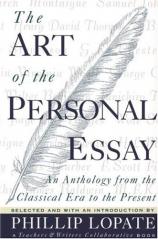Excerpt
Excerpt
The Art of the Personal Essay

While it may be argued that the essays themselves reveal the most about the history and form of this genre, Phillip Lopate's introduction is a wonderful (and quite amusing) way to get to know the personal essay. The following are excerpts from that introduction:
This book attempts to put forward and interpret a tradition: the personal essay. Though long spoken of as a subcategory of the essay, the personal essay has rarely been isolated and studied as such. It should certainly be celebrated, because it is one of the most approachable and diverting types of literature we possess.
The hallmark of the personal essay is its intimacy. The writer seems to be speaking directly into your ear, confiding everything from gossip to wisdom. Through sharing thoughts, memories, desires, complaints, and whimsies, the personal essayist sets up a relationship with the reader, a dialogue--a friendship, if you will, based on identification, understanding, testiness, and companionship.
* * *
The personal essayist must above all be a reliable narrator; we must trust his or her core of sincerity. We must also feel secure that the essayist has done a fair amount of introspective homework already, is grounded in reality, and is trying to give us the maximum understanding and intelligence of which he or she is capable. A dunderhead and a psychotic killer may be sincere, but that would not sufficiently recommend them for the genre...
How the world comes at another person, the irritations, jubilations, aches and pains, humorous flashes--these are the classic building materials of the personal essay. We learn the rhythm by which the essayist receives, digests, and spits out the world, and we learn the shape of his or her privacy.
* * *
The essay is a notoriously flexible and adaptable form. It possesses the freedom to move anywhere, in all directions. It acts as if all objects were equally near the center and as if "all subjects are linked to each other" (Montaigne) by free association. This freedom can be daunting, not only for the novice essayist confronting such latitude but for the critic attempting to pin down its formal properties...
The essayist attempts to surround a something--a subject, a mood, a problematic irritation--by coming at it from all angles, wheeling and diving like a hawk, each seemingly digressive spiral actually taking us closer to the heart of the matter.
* * *
There is something heroic in the essayist's gesture of striking out toward the unknown, not only without a map but without certainty that there is anything worthy to be found. One would like to think that the personal essay represents a kind of basic research on the self, in ways that are allied with science and philosophy....
Still, we must not make excessive claims. The essay is not, for the most part, philosophy; nor is it yet science. How seriously ought we to take its claims of being experimental? It lacks the rigor of a laboratory experiment; it does not hold on to its hypotheses long enough to prove them. But it is what it is: a mode of inquiry, another way of getting at the truth.
Excerpted from The Art of the Personal Essay, edited by Phillip Lopate. Introduction copyright © 1994 by Phillip Lopate. Reprinted by permission of Anchor Books, a division of Bantam Doubleday Dell Publishing Group, Inc. No part of this excerpt may be reproduced or republished without permission in writing from the publisher.
The Art of the Personal Essay
- paperback: 777 pages
- Publisher: Anchor
- ISBN-10: 038542339X
- ISBN-13: 9780385423397

